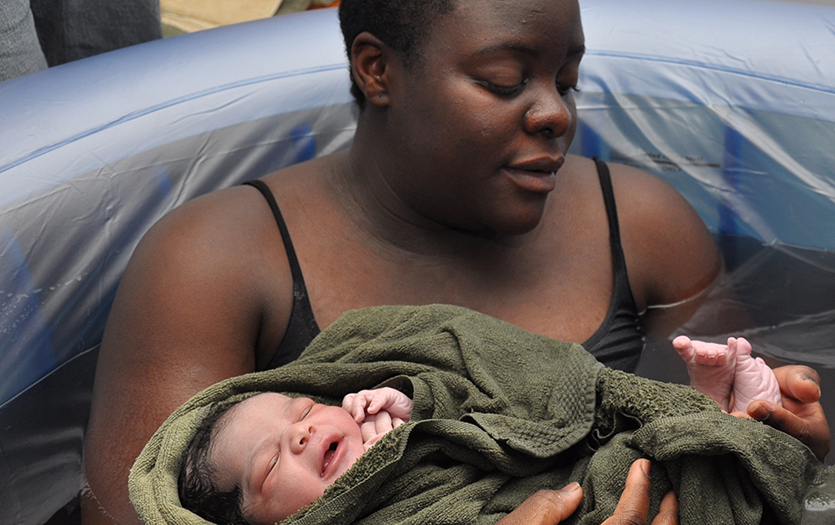
This post was written by Kate Confer, CNM, Parkview Health.
When water immersion is used during the second or pushing stage of labor and the infant is born while the mother is immersed in water, the intervention is termed a water birth. This effective method of pain management promotes upright positioning and movement for mothers during labor. Water immersion is an amazing option for women with low-risk pregnancies and normal labor. In this post, we cover the process of a water birth, its advantages for mothers and babies as well as potential risks to consider.
What happens during a water birth?
At the Parkview Randallia Family Birthing Center, we have inflatable tubs and water birth tub kits available for purchase. When the mother is ready, the birthing tub is brought into the room and only filled with enough warm water to cover her belly. The mother, as she desires, can then labor and/or deliver in the tub. A nurse or midwife will frequently assess fetal heart tones using a Doppler ultrasound monitor for normal heart rate throughout the process.
Water birth is considered a hands-off approach. It empowers the mother to lead the birthing process and encourages her to push instinctively. Unlike a traditional birth, the midwife does not physically help the baby deliver but is present to oversee and offer support if necessary.
Once fully delivered, either the mother, father or midwife will slowly bring the newborn out of the water within 10 seconds for immediate skin-to-skin contact and assessment. After delayed cord clamping, the mother is assisted from the tub to the bed to deliver the placenta. Delivering the placenta in the bed allows for a more accurate determination of maternal blood loss.
Benefits for the mother
For women seeking a physiological birth and prefer to avoid the use of pharmacological pain relief methods (narcotics or an epidural), water immersion delivery offers many benefits including:
- Promotes comfort, peace and relaxation.
- Can help the mother conserve energy and facilitate faster labor.
- Offers the mother more control over the second stage of labor.
- Increases satisfaction with labor and birthing process.
- Allows immediate contact with the newborn.
- Reduces frequency and severity of perineal trauma.
Benefits for the child
Research tells us that babies born in water experience increased APGAR scores after 3 minutes compared to those born in traditional beds. This test is a way to assess a newborn beyond their vital signs. It evaluates how they transition from womb to room based on their appearance (color), pulse, grimace, activity and respiration.
The positive impact of water births on newborns can also include:
- Fewer infections and NICU admissions.
- Gentle transition from womb to room.
- Immediate skin-to-skin contact.
- Delayed cord clamping.
- No exposure to narcotics via placental transmission.
Are there any risks associated with water birth?
Certain criteria can exclude women from having a water birth. These can be determined during pregnancy or even during labor. While we want to help women meet their birth plan goals for labor and delivery, our top priority is to ensure the safety of both mother and child. Water births are generally considered safe, but it’s crucial to be aware of the risks this birthing method poses for both mother and newborn.
Potential risks of water birth can include:
- Difficulty lifting the baby above the water for their first breath.
- Torn umbilical cord.
- Increased maternal temperature can cause a baby’s heart rate to increase.
- Inaccurate determination of blood loss in water.
- Increased risk of dehydration.
- Problems with the baby may go undetected without continuous fetal heart rate monitoring.
What advantages do water births in a hospital setting offer?
Providing water births in a hospital setting expands a mother’s options for pain management and facilitates more physiologic labor and birth. This approach offers a safety net of resources for the mother and child. In the rare case that there is an emergency, being in a hospital allows for more immediate action and no delay in care.
Learn more
Since its implementation in November 2023, the Certified Midwife Program has attended 16 successful water births at the Parkview Randallia Family Birthing Center—and counting! If you’re considering a water birth or want to learn more about this method, Parkview Family Birthing Centers is here to help. Visit our website and connect with our team of nurse navigators to access the resources you need to support your growing family.



